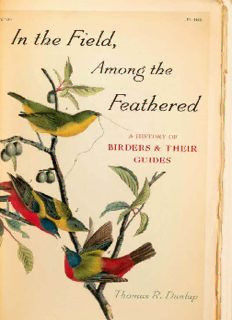
In the Field, Among the Feathered: A History of Birders and Their Guides PDF
Preview In the Field, Among the Feathered: A History of Birders and Their Guides
In the Field, Among the Feathered This page intentionally left blank In the Field, Among the Feathered A H i s t o r y o f B i r d e r s & T h e i r G u i d e s Th omas R. Dunlap 3 Oxford University Press, Inc., publishes works that further Oxford University’s objective of excellence in research, scholarship, and education. Oxford New York Auckland Cape Town Dar es Salaam Hong Kong Karachi Kuala Lumpur Madrid Melbourne Mexico City Nairobi New Delhi Shanghai Taipei Toronto With offi ces in Argentina Austria Brazil Chile Czech Republic France Greece Guatemala Hungary Italy Japan Poland Portugal Singapore South Korea Switzerland Th ailand Turkey Ukraine Vietnam Copyright © 2011 by Oxford University Press, Inc. Published by Oxford University Press, Inc. 198 Madison Avenue, New York, NY 10016 www.oup.com Oxford is a registered trademark of Oxford University Press All rights reserved. No part of this publication may be reproduced, stored in a retrieval system, or transmitt ed, in any form or by any means, electronic, mechanical, photocopying, recording, or otherwise, without the prior permission of Oxford University Press. Library of Congress Cataloging-in-Publication Data Dunlap, Th omas R., 1943– In the fi eld, among the feathered : a history of birders and their guides / Th omas R. Dunlap. p. cm. Includes bibliographical references and index. ISBN 978-0-19-973459-7 1. Bird watching—United States—History. 2. Bird watchers—United States—History. 3. Birds—United States—Identifi cation—History. I. Title. QL677.5.D83 2011 598.072′3473—dc22 2011009169 1 3 5 7 9 8 6 4 2 Printed in the United States of America on acid-free paper For my brother Dave and my sister Martha, my constant family readers This page intentionally left blank Contents Acknowledgments · ix Introduction · 3 Part I Gett ing Started ONE Shooting Birds with Opera Glasses · 13 TWO A Book for a Hobby, 1889–1920 · 37 Part II Th e Mature Guide & the Popular Hobby THREE Knowledge & Skills · 67 four Th e Field Guide Comes of Age · 91 five Birds over America · 117 Part iii Environmental Birding six Birding in a Silent Spring · 147 seven Environmental Birding · 175 Conclusion: Th e Gyre · 201 Notes · 207 Bibliography · 227 Index · 237 This page intentionally left blank Acknowledgments Th e History Department and the College of Liberal Arts at Texas A&M University provided me a fi ne situation in which to work, and I thank them, and my department head, Dr. Walter Buenger. For an uninter- rupted year in which to write—a precious commodity indeed—I thank the National Science Foundation for its support under SES grant 0550268, and Dr. Ronald Rainger, the project offi cer who steered the proposal from rough idea to clear application. During the writing I had what I have come to think of as my usual conversations with Bill Cronon. Th is book would not have been the same without his friendship, advice, and analysis. I shared birding fi eld trips with Kurk Dorsey at the Ameri- can Society for Environmental History, and he reviewed the manu- script. I tried out my ideas on far too many friends to mention each by name, but they all have my deep thanks. Like all researchers I rely on archives, and I thank the following not only for permissions but also for staff assistance, invariably friendly and helpful: the Wisconsin State Historical Society for a copy of my taped interview with Joseph J. Hickey; the Roger Tory Peterson Institute in Jamestown, New York, for access to Peterson’s extensive correspon- dence, library, and specimen collection; the Museum of Vertebrate Zo- ology in Berkeley, California, for its correspondence fi les, which I have been using for research for more than twenty years; the American Mu- seum of Natural History in New York for the correspondence of Frank M. Chapman; the Cornell University Library for access to the Ludlow Griscom Papers; and the Th omas J. Dodd Research Center at the Uni- versity of Connecticut for the Edwin Way Teale Papers. I also thank the editorial team at Oxford University Press for the alchemy that turns manuscript into book, with my special thanks to Susan Ferber, whose
Description: